
Solid ANC… for a Price
As we said back in 2017, when the Beats Studio3 Wireless headphones debuted, Beats’ products have been getting better and better since Apple bought the company and started contributing to their design and hardware. The new Beats Studio Pro, the first new addition to the Beats Studio line in six years, bring excellent ANC performance plus a built-in DAC supporting high-res audio through a USB-C connection. But the headphones also feel like some important features are MIA, making their $350 price tag a harder sell for some users.
Although it’s arguably the brand that made wearing chunky headphones everywhere seem cool, Beats has actually spent the past four years focusing its efforts on its wireless earbuds lineup, with some excellent results. We struggled to find a reason why anyone shouldn’t grab the $200 Beats Fit Pro, and strongly believe that anyone considering AirPods should go with the $170 Beats Studio Buds + instead. Beats’ wireless earbuds have become strong competition for Apple’s other audio brand.
The last pair of wireless headphones from Beats was 2019’s Beats Solo Pro, which we liked, but didn’t think entirely justified their $300 price tag. That’s more or less the same story with the new Beats Studio Pro. They bring lots of solid upgrades to the aging Beats Studio3 Wireless, but by skipping Apple’s H1 wireless chip for proprietary hardware, the Beats Studio Pro are definitely not the affordable alternative to the $550 AirPods Max that some Apple fans had hoped for when word of the new headphones first leaked.
A Familiar Design That’s Survived Over a Decade
Thanks to aggressive marketing, Beats have always been some of the most recognizable headphones on the market, and not just because of the lowercase ‘b’ branding on each earcup. The company found a design that clicked with consumers, made it cool through marketing and celebrity endorsements, and has more or less stuck with it for well over a decade.
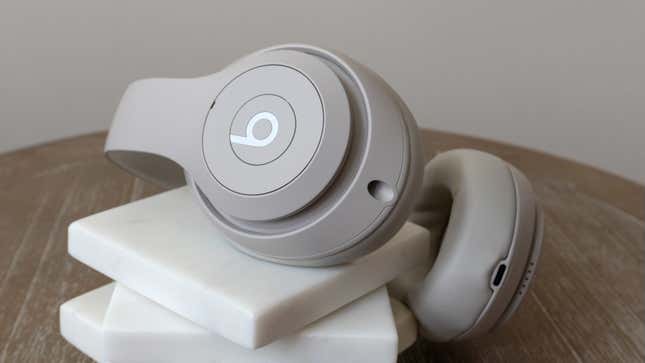
Unlike the now discontinued Beats Solo Pro which looked more heavily influenced by Apple’s designers, the new Beats Studio Pro look very similar to the Beats Studio3 Wireless, and the older Beats Studio headphones that came before them.
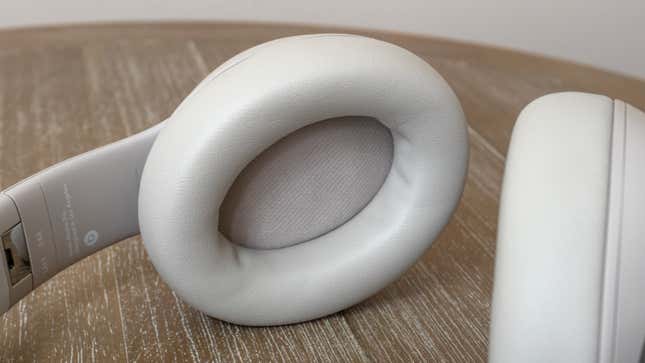
They are unmistakably Beats headphones, with a few small updates. One common complaint about Beats headphones is that the headband tends to deliver quite a strong clamping force on the wearer’s head and ears, resulting in discomfort when worn for extended periods. The Beats Studio Pro don’t feel as aggressively strong as previous models, which could be a result of the use of softer memory foam in the earcups providing more cushioning, but they do form a very tight seal, and on several occasions, I’ve taken them off with an audible “sigh” at the pressure relief on my ears.
And despite Apple beating the sustainability drum every time Tim Cook gets on stage to announce new products, unlike the AirPods Max, or other headphones that promote repairability, the memory foam earcups on the Beats Studio Pro are unfortunately not removable or easily replaceable.
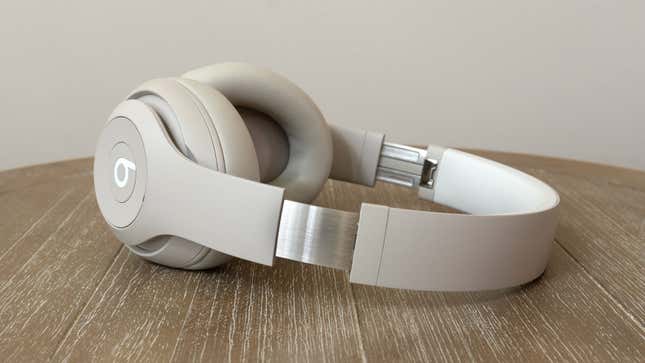
I’m also surprised that for a brand that puts a strong emphasis on aesthetics, the Beats Studio Pro’s adjustable headband isn’t exactly pretty. The design of the headbands on both the Apple AirPods Max, and the Sony WH-1000XM5, manage to cleverly hide when the headband has been extended to fit larger heads, but on the Beats Studio Pro, extending the headband splits its plastic housing and exposes the metal band inside it. It’s an approach that many other headphones use, but for $350, I expect something more aesthetically pleasing.
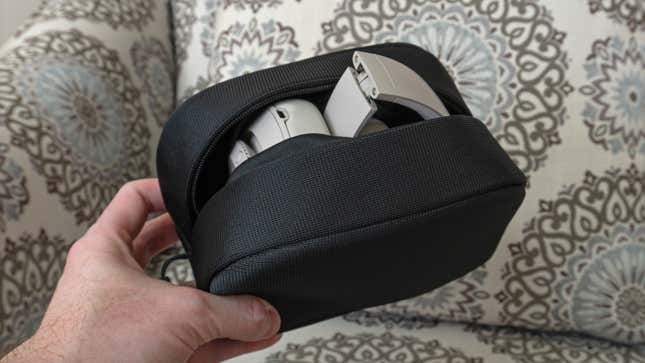
I do, however, like that the headband on the Beats Studio Pro has a pair of hinges allowing the headphones to fold quite small so they can squeeze into an included carrying case that’s not much bigger than a toiletries bag. If we ever see an update to the AirPods Max, let’s hope that Apple’s audio team is paying attention and includes a proper carrying case like this next time, and not the weird diaper the first-gen AirPods Max are forced to wear out in public.
An Apple Product That Caters to Androids Too
Despite being a brand that’s owned by Apple, Beats’ headphones and earbuds don’t functionally cater to just iPhones, iPads, and Macs like AirPods do. In fact, the new Beats Studio Pro includes some features that are Android only.
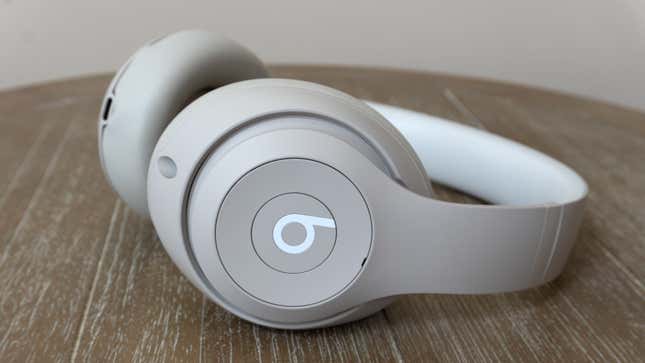
As with previous generations of the Beats Studio headphones, functionality through the headphones themselves is kind of basic—there are no touchpads you can swipe to control your music or dials you can turn to make volume adjustments. On the left earcup, the ‘b’ branding is a simple button that can be pressed, double-pressed, and triple-pressed to control music playback, or held down to activate voice assistants. With the Beats Studio Pro connected to Apple devices, Siri is also accessible by just saying, “Hey, Siri,” out loud, but hands-free access to Google Assistant when connected to Android devices isn’t an option.
Pressing just above or just below the ‘b’ you’ll also find a pair of hidden clicky buttons that allow for quick volume adjustments. I would find them easier to locate while wearing the headphones if they had a subtle bump or indent you could feel, but dedicated volume buttons are always much appreciated.
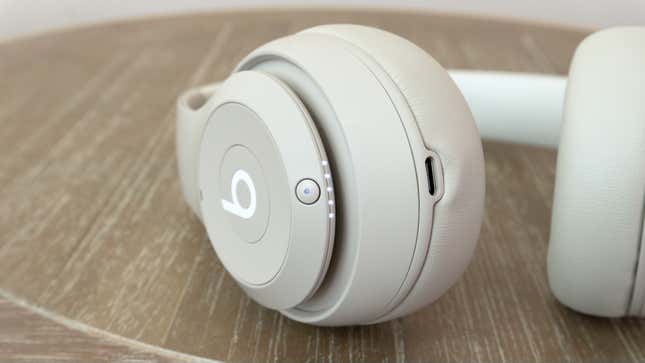
The right earcup features a much smaller “system button” that’s used to power the headphones on and off, activate Bluetooth pairing, and toggle between noise cancellation, transparency, or turn both modes off. For the first time, the USB-C connection on the right earcup which is primarily used to charge the headphones after 40 hours of use (or 24 hours with ANC or transparency turned on) also supports USB-C audio.
The Beats Studio Pro includes a built-in digital-to-analog converter (DAC) allowing high-resolution audio files and streams (up to 24bit/48kHz) to be accessed, and while ANC and transparency modes are disabled while listening to audio over a USB-C connection, users can select between three different EQ settings. Unfortunately, these EQ settings are limited to a balanced mix, a mix that caters to movies and games, and a mix that boosts voices when making calls or listening to podcasts. There are no adjustable EQ options when listening to audio over Bluetooth, which, again, feels like another feature that’s genuinely lacking on a pair of $350 headphones.
Beats has also skipped using Apple’s W1 or H1 audio chips in the new Studio Pro, in favor of proprietary hardware. It will still do head tracking if you’re sold on the Spatial Audio hype, supports lost device tracking, and allows the Beats Studio Pro to easily switch between multiple devices, but only those running Android or ChromeOS. The headphones can only connect to one Apple device at a time, and I was also disappointed to find the new Beats Studio Pro don’t feature wear detection, so when taking them off, your music or video playback doesn’t automatically pause.
The Beats Studio Pro Sound Surprisingly Good
Although Beats has seemingly decided not to get caught up in the active noise cancellation arms race happening between Sony, Apple, and Bose, I was actually quite surprised at how good the ANC on the new Beats Studio Pro is. Listening to audio samples of various noisy environments blasting through my home theater setup, the Beats Studio Pro did a very good job at gutting lower frequencies like the deep rumbles you’ll hear while riding a bus or during a flight on a large commercial airliner.
Most real-time ANC hardware still struggles with higher frequencies—you’re still going to hear the cacophony of voices in a busy coffee shop with ANC turned on, but they’ll end up much quieter. The ANC on the Beats Studio Pro is definitely better than what you’ll get from any of Beats’ wireless earbud products, but that’s also because of the added sound blocking from the earcups that completely cover your ears. The Beats Studio Pro don’t outperform the Apple AirPods Max or the Sony WH-1000XM5 when it comes to their noise-canceling capabilities, but feel on par with the last generation Sony WH-1000XM4, which are still very good headphones.
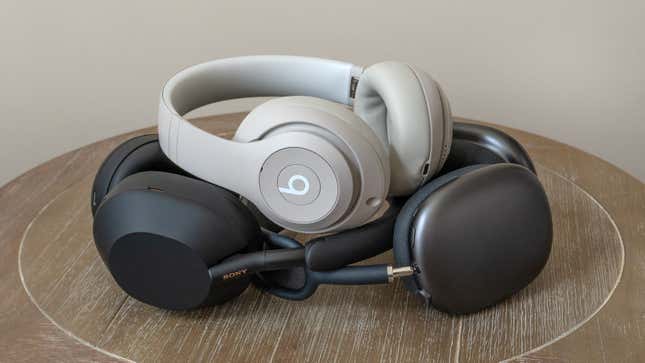
Without any ability to make EQ adjustments, you’re more or less stuck with the Beats Studio Pro’s out-of-the-box tuning, which for past models we’ve described as sounding “dreadfully adequate.” I wouldn’t be quite so harsh describing the Beats Studio Pro’s sound, but I did find it to be far less aggressive than how I thought the headphones were going to sound. Deeper bass beats and kick drum hits don’t have as much thump as you get from the Sony WH-1000XM5 (which I find are actually a bit too bass-heavy out of the box, but can be remedied through in-app EQ adjustments) and almost feel a bit muted through the Beats Studio Pro.
The same goes for vocals, or electronic tracks with a lot of higher frequency hits. It almost sounds like the frequency range of most tracks has been compressed on the high and low ends passing through the Beats Studio Pro. I wouldn’t necessarily call it disappointing, and comparing the sound to what you’ll get from the Apple AirPods Max isn’t fair given those are $549 headphones, but if audio quality is your number one priority, you can do better than the Beats Studio Pro at this price point.
Are the Beats Studio Pro Worth the Upgrade?
If you can’t imagine being spotted out in public wearing anything other than Beats headphones, then sure, the new Beats Studio Pro are definitely a welcome upgrade over both the Beats Studio3 Wireless, and the Beats Solo3 Wireless. The ANC is noticeably better than its predecessor (which isn’t that surprising given the Beats Studio3 Wireless are six years old at this point) and actually comes close to ANC champs like the Apple AirPods Max, and the Sony WH-1000XM5—but the Beats Studio Pro are definitely not a step-up over either of those.
If I was spending $350 on wireless headphones, I would either find a way to squeeze my budget a little tighter to grab the $400 Sony WH-1000XM5 instead, which offer better ANC, multi-device connectivity, and wear detection, or opt for Sony’s last generation wireless headphones, the Sony WH-1000XM4, which are still $350 but can frequently be found for much cheaper than that. Beats headphones, which once defined the brand, have seemingly taken a back seat to its wireless earbuds, which do a great job of delivering a lot of functionality at a competitive price point. At $150-$200, the new Beats Studio Pro would have been an excellent offering, but for $350, you can find better alternatives.
Want more of Gizmodo’s consumer electronics picks? Check out our guides to the best phones best laptops, best TVs, and best headphones. If you want to learn about the next big thing, see our guide to everything we know about the iPhone 16.

